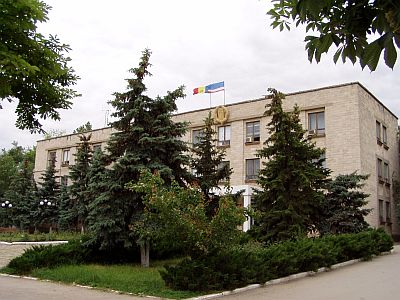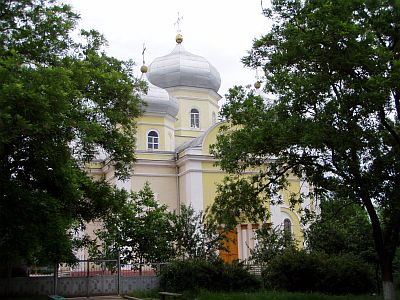Official Name
Comrat. Also very common is the spelling Komrat. The Cyrillic spelling is very often used as well - as for example on buses and timetables etc: Комрат (Komrat).
Location

| ||
| Comrat |
Comrat lies in the south of Moldova more than 80 km away from the capital →Chişinău. The town sprawls along the tiny river Ialpug. The area around the town is rather hilly. The border with the →Ukraine in the east is less than 25 km away; the border with →Romania in the west some 40 km.
Population
Comrat has around 25,600 inhabitants and is the largest town in the Autonomous Republic of Gagauzia. The entire republic has a population of 158,900 people.
About Găgăuzia (Gagauzia)

| ||
| Gagauzian Flag |
The republic of Moldova has a wide ethnic diversity with Ukrainian, Russian, Gagauz, Bulgarian and other minorities. At least three minorities were not satisfied with the declaration of independence in the year 1991 and therefore demanded the dissolution of the new republic in order to gain their own independence. Russians and Ukrainians, backed by Russia, fought a short war against Moldova in 1992 and founded the →PMR (Transdniestr), which is internationally not recognized.
Riots broke out in Gagauzia as well. Rumours say, that troublemakers from Transdniestr played their own role in Gagauzia at that time. However, the central government in Chisinau and the Gagauzian leaders agreed on a sustainable solution, granting Gagauzians a high level of autonomy. The autonomy contract was signed in 1994. Ever since, it's quiet calm in the south. The Gagauzians have their own parliament, which is electing the Başkan (head) of the republic. Gagauzians enact their own laws, providing that the law is not inconsistent with Moldovan law. The republic even has its own constitutional law.
Gagauz Yeni, that's the official name of the republic, covers an area of 1,831 km² and has, as already mentioned above, about 158900 inhabitants. Around 80% of the population are ethnic Gagauzians. Minorities include Bulgarians, Russians and Ukrainians, with all of them being equally strong. According to various estimations, there are some 250,000 Gagauzians worldwide. Most of the Gagauzians not settling in Moldova live in the →Ukraine and in →Bulgaria. The autonomous republic doesn't consist of a single area but of four territories not being connected with each other. All of them are in the south-east of Moldova. The region around and south of Comrat is the largest of the four territories. (for a map refer to the website about →Moldova).

| ||
| National Assembly of Gagauzia in Comrat |
The Gagauzians are a Turk tribe speaking a Turkic language - so much about the common point in most theories. The name might derive from the word Uz (also: Oguz), which gradually changed into Hagoguz and finally into Gagauz. The recent name first appeared in the 19th century. The Gagauz probably originally settled in the area between the Aral Sea and the Caspian Sea. Later, they moved to the Dobrucha, which is the area around the city of →Dobrich. The Gagauz converted from Islam to Orthodox Christianity sometime. This had an influence on the language. Gagauz belongs to the →Turkish language group, but all the vocabulary deriving from the qur'ān is missing. In contradiction to that, there are many Christian and Slavic words. During the Ottoman occupation, the Gagauz enjoyed the same autonomous rights as they do today. During and after the Second World War, many Gagauz were deported and lost their lives. Today, the Gagauz language and culture is very much supported, esp. thanks to a strong relationship with →Turkey. There's even a Gagauz university based in Comrat.
Orientation
Comrat is the capital of the Autonomous Republic of Gagauzia, but it's a young town with less than 30,000 inhabitants, so there's not really much to see. The bus station lies north of the 'centre' close to a roundabout. From there, the road to →Chişinău leads northwards, the other two southwards: One is the ул. Ленина (ul. Lenina, Lenin rd) to the right and the other one ул. Победы (ul. Pobedy, Victory rd.) to the left. Right, nothing has changed. And all place names are written in Cyrillic script. The dustry central square stretches along Victory road. In front of the square to the right, there's a small market. A large park including a church sprawls between the two roads. The National Assembly faces Lenin rd. There are almost no historic buildings at all.
Getting there / transportation
Comrat is not connected to the railway network, so the bus is the only way to get there. Buses to Comrat and other towns in the south leave from the Sud-Vest bus station in the capital (see also →Chişinău: Getting there). The ride takes around 2 hours, the fare is 18 Lei (€ 1.3) per person. All buses heading for towns and villages further to the south stop in Comrat. There's even a direct connection to Измаїл (Ismail) at the river Danube in the →Ukraine. Smaller buses run to Cahul (not far from there is a minor border crossing with →Romania), Vulcăneşti (another Gagauz enclave) and even to →Tiraspol.
There's not much to see in Comrat - it's a small, dusty and sleepy provincial town. In contradiction to the capital, almost everything is written in Cyrillic letters. The National Assembly, so to say the most important building in the Gagauz republic, can be found on the right side of Lenin street when coming from the bus station. Thanks to the Moldovan and Gagauz flag on the roof, it's easy to spot. Opposite the administration building, there's a nice green park with a small playground and an Orthodox church, which has been restored a couple of years ago.

| ||
| St John Church in the centre of Comrat |
The church is characterized by the typical orthodox onion-shaped dome and a separate, quite tall belfry. Behind the park there's the Victory road and the main square. Not far from the square, there's a tiny lane used as the local market spot. There, locals sell self-grown vegetables and fruits and some other things. Except for a modern (but not very good) restaurant called Pizza House on Lenin street, time has stood still in Comrat.
There's almost no industry around the area, but a lot of agriculture. Which is nothing special in Moldova. There are countless vineyards in the vicinity. Halfway between the capital and Comrat, you might notice unusual place names such as Marienfeld - a characteristic German place name. Centuries ago, the area was dotted with German villages, but most of the Germans have left the country (or were deported by Stalin). After that, many villages were renamed.
There's a small hotel right at Victory square. However, there's no reason to stay in Comrat unless you know someone living there.
- www.jmu.edu Interesting study of Gagauzia and Transdniestr. In English.
- www.ozturkler.com Extensive information about Gagauzia and the Gagauz nation. Not completely free of propaganda, but interesting. In English.
Do you have or do you know a good website about Comrat or Gagauzia? Don't hesitate, let me know! After checking it, I would love to add it to the link list. You can submit a link by using the →contact form. Note that commercial websites will be treated differently.
©2024 Europe-East.com

 Albania
Albania Moldova
Moldova